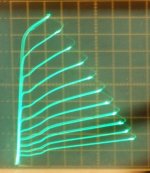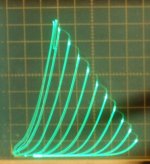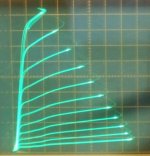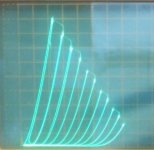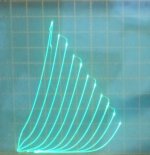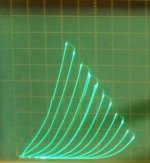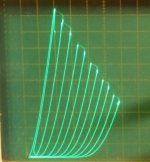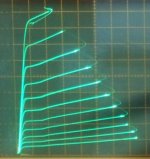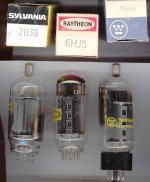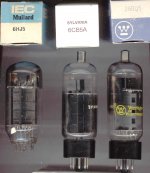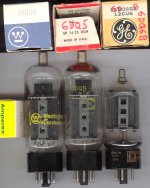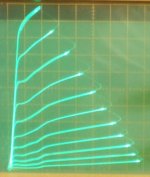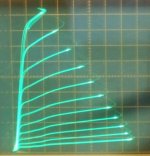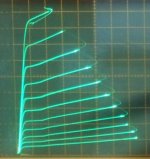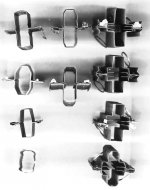Hi everyone,
Would anybody have the pin out and plate curves for the 26DQ5. Hunted the web and can't seem to find the data.
thanks
Would anybody have the pin out and plate curves for the 26DQ5. Hunted the web and can't seem to find the data.
thanks
Doing a search I can find its equivalent the Russian 30P1S
30P1S ... - Datasheet Search Engine Download
30P1S ... - Datasheet Search Engine Download
Here is the Sylvania datasheet for the 6DQ5 (same thing):
http://frank.pocnet.net/sheets/106/6/6DQ5.pdf
26DQ5 curves: pentode, triode, Schade (Mu 4) 50mA/div Vert., 50 V/div Horiz.
The 26DQ5/6DQ5 is fairly similar to the 6HJ5 (no cap): pentode, triode, Schade
ESRC has the 26DQ5 for $3 and Vacuumtubes.net has the 6HJ5 for $4, and also the 21LG6 for $4 (also similar)
http://frank.pocnet.net/sheets/106/6/6DQ5.pdf
26DQ5 curves: pentode, triode, Schade (Mu 4) 50mA/div Vert., 50 V/div Horiz.
The 26DQ5/6DQ5 is fairly similar to the 6HJ5 (no cap): pentode, triode, Schade
ESRC has the 26DQ5 for $3 and Vacuumtubes.net has the 6HJ5 for $4, and also the 21LG6 for $4 (also similar)
Attachments
Last edited:
I found 25DQ6, oddly enough.
Assuming it is the same as a 6DQ5:
http://www.mif.pg.gda.pl/homepages/frank/sheets/106/6/6DQ5.pdf
Though in the RCA and Sylvania pages anyway, I see no reference to other heater voltages.
Assuming it is the same as a 6DQ5:
http://www.mif.pg.gda.pl/homepages/frank/sheets/106/6/6DQ5.pdf
Though in the RCA and Sylvania pages anyway, I see no reference to other heater voltages.
The 26DQ5 I got from ESRC were Westinghouse (Japan F5). Quite nice looking tubes. Octal.
Pics of the 26DQ5, 6HJ5, 21LG6 all quite similar tubes spec-wise. 6HJ5 has no plate cap., 21LG6 is 28 Watt P diss instead of 24 Watt and only 2 Amp heater.
21LG6 pentode, triode, and Schade curves for comparison.
At only $3 or $4 each, one should have the whole bunch (and spares) in their collection for experimenting. 6HJ5 was popular with the big red board (Pete's DCPP engineers amp) using George's (Tubelab) modifications. I'm sure any of them would work fine there.
And some pics of 26DQ5, 6CB5, and 6HJ5 for comparison.
Pics of the 26DQ5, 6HJ5, 21LG6 all quite similar tubes spec-wise. 6HJ5 has no plate cap., 21LG6 is 28 Watt P diss instead of 24 Watt and only 2 Amp heater.
21LG6 pentode, triode, and Schade curves for comparison.
At only $3 or $4 each, one should have the whole bunch (and spares) in their collection for experimenting. 6HJ5 was popular with the big red board (Pete's DCPP engineers amp) using George's (Tubelab) modifications. I'm sure any of them would work fine there.
And some pics of 26DQ5, 6CB5, and 6HJ5 for comparison.
Attachments
Last edited:
I found 25DQ6, oddly enough.
Assuming it is the same as a 6DQ5
That's a dangerous assumption; it doesn't work that way. You have types like the: 50C5, 25C5, 17C5, 12C5 -- all the same except for heater voltages. (Stick the 6CU5 in there as well since it's a 6.3V 50C5, but 6C5 was already taken (Octal, metal singleton SS triode) ) The 35C5 may look like a "35V", 50C5, but it isn't. That's a different type. Same as the 50L6 is definitely not a "50V" 6L6 -- both completely different, and much more than the 35C5/50C5.
http://www.mif.pg.gda.pl/homepages/frank/sheets/106/6/6DQ5.pdf
Though in the RCA and Sylvania pages anyway, I see no reference to other heater voltages.
The "RC-30" RCA Receiving Tube Manual makes no mention that the 6DQ5 ever came with heaters other than 6.3V, and there's nothing referencing a 26DQ5 or a 25DQ5.
Thanks Miles...this is what I am cautious about. I want to be sure of the pins.
Odd that the tube is around and no curve charts for it. The one I have appears to be Mullard but nothing on that one either. Can't even find a cross for it.
Odd that the tube is around and no curve charts for it. The one I have appears to be Mullard but nothing on that one either. Can't even find a cross for it.
There are plenty of examples on both sides of the big pond where a different heater designation does not imply that the rest of the tube is the same.
the 12L6, 25L6, 35L6 and 50L6 are NOT different heater versions of the 6L6, although they do share the same pinout.
The UL84 is not a 45 volt EL84 although they do share the same pinout.
I have some 26DQ5's and they are 26 volt 6DQ5's although they may not be as tough as the original RCA's. The set I have are Japanese made Westinghouse like those smoking-amp has. The 26 volt version probably originated in Japan and may have been used in an imported TV or two resulting in a US type number. I remember wiring some of them up in a P-P amp several years ago, but never saw a reason to buy any. Probably because I got a bunch of 25DN6's for 50 cents each.
Enzo refers to a 25DQ6 not 25DQ5. I have one of these, and it LOOKS like a 6DQ6, but I have never tried to power it up since I only have one and it looks well used. The Tung Sol data confirms that it is indeed a 25 volt 6DQ6.
the 12L6, 25L6, 35L6 and 50L6 are NOT different heater versions of the 6L6, although they do share the same pinout.
The UL84 is not a 45 volt EL84 although they do share the same pinout.
no mention that the 6DQ5 ever came with heaters other than 6.3V, and there's nothing referencing a 26DQ5 or a 25DQ5.
I have some 26DQ5's and they are 26 volt 6DQ5's although they may not be as tough as the original RCA's. The set I have are Japanese made Westinghouse like those smoking-amp has. The 26 volt version probably originated in Japan and may have been used in an imported TV or two resulting in a US type number. I remember wiring some of them up in a P-P amp several years ago, but never saw a reason to buy any. Probably because I got a bunch of 25DN6's for 50 cents each.
Enzo refers to a 25DQ6 not 25DQ5. I have one of these, and it LOOKS like a 6DQ6, but I have never tried to power it up since I only have one and it looks well used. The Tung Sol data confirms that it is indeed a 25 volt 6DQ6.
It 'appears' that the 6DQ5 and the 26DQ5 have the same pin out. Still can not find plate curves to be sure of plate/bias/current andgm numbers.
However a Hickok WE L1 that is here has the 26DQ5 and the set up is the same less the filament. Trusting that the WE numbers are correct, I checked the Triplett 3444 for 6DQ5 and the pin out match.
Using the 3444 bias, plate, and gm settings for the 6DQ5 and 26DQ5 filament, I do get what appears to be viable numbers. Since this 3444 has a custom built-in digital plate current meter, I am seeing 53.4ma at 245vdc, bias 30, gm 7200 with a signal of 100vacmv at 5050Hz.
Now if I just had that plate curve chart I could rest assured.
The 26DQ5 does appear to have been of Japanese manufacture, Toshiba, Sharp, Hitachi, all seem to have made it for others.
However a Hickok WE L1 that is here has the 26DQ5 and the set up is the same less the filament. Trusting that the WE numbers are correct, I checked the Triplett 3444 for 6DQ5 and the pin out match.
Using the 3444 bias, plate, and gm settings for the 6DQ5 and 26DQ5 filament, I do get what appears to be viable numbers. Since this 3444 has a custom built-in digital plate current meter, I am seeing 53.4ma at 245vdc, bias 30, gm 7200 with a signal of 100vacmv at 5050Hz.
Now if I just had that plate curve chart I could rest assured.
The 26DQ5 does appear to have been of Japanese manufacture, Toshiba, Sharp, Hitachi, all seem to have made it for others.
Here is a pic of the Westinghouse 26DQ5, a Raytheon 6DQ5, and an RCA 6DQ6 (wrong box came with it).
The 26DQ5 internals certainly look quite similar to the 6DQ5. Looking through the grid alignment holes, the grids appear to have the same aligned wire spacing and similar spacings from the cathode.
I'm pretty sure I compared these two tubes on the curve tracer before (usually against the 6HJ5), but I can put them on again.
The 26DQ5 internals certainly look quite similar to the 6DQ5. Looking through the grid alignment holes, the grids appear to have the same aligned wire spacing and similar spacings from the cathode.
I'm pretty sure I compared these two tubes on the curve tracer before (usually against the 6HJ5), but I can put them on again.
Attachments
Smoking was the first to offer that the 6v tube MIGHT be related. I offered it up as a lead in to posting data sheets IN CASE they were the same. I had no intent to imply they necessarily WERE the same. That is what "Assuming they are the same" meant. Many cases exist where the different heater numbers are different tubes inside, however there are also many cases where the various heater voltage versions of a type number are otherwise the same inside. One must determine that in each case.
Here are the pentode curve traces for the Raytheon 6DQ5 and the Westinghouse 26DQ5.
For both: 50 mA/div Vertical, 50 V/div. Horiz., 110 V on g2, -3 V steps from 0V for g1
Looks like they would pass for a matched pair, they are so close. There's usually more spread in the characteristics within a given tube type. Just got lucky here.
Also attached are the 6HJ5 and 21LG6 pentode curves for comparison. I'm sure they were 50 mA/div Vertical and 50 V/div Horiz. too, but the Vg2 and g1 steps might have been a little different. (taken years ago, no record) Their datasheet specs are quite similar though, so settings would not be off by much difference.
One point of interest between these similar tubes. The 26/6DQ5 does not have (internal) Barkhausen plates. The 6HJ5 has small ones, and the 21LG6 has the later deep pocket Barkhausen plates with an external wing fin for cooling. You can see the tetrode kinks improve from left to right. An RCA paper I saw explained that the Barkhausen plate evolution was found to reduce secondary emission, by causing most of the electron stream to hit the Bark plates at grazing incidence, then bounce to the plate for capture. The usual audio mythology says that the Barkhausen plates sound worse. I think they got that one wrong, but there may be a general increase in design gm with the later tubes that accounts for some increase in non-linearity (at least for some tubes). Two different phenomena. I'll take the Barkhausen plates, at least after checking the curves on the tracer.
For both: 50 mA/div Vertical, 50 V/div. Horiz., 110 V on g2, -3 V steps from 0V for g1
Looks like they would pass for a matched pair, they are so close. There's usually more spread in the characteristics within a given tube type. Just got lucky here.
Also attached are the 6HJ5 and 21LG6 pentode curves for comparison. I'm sure they were 50 mA/div Vertical and 50 V/div Horiz. too, but the Vg2 and g1 steps might have been a little different. (taken years ago, no record) Their datasheet specs are quite similar though, so settings would not be off by much difference.
One point of interest between these similar tubes. The 26/6DQ5 does not have (internal) Barkhausen plates. The 6HJ5 has small ones, and the 21LG6 has the later deep pocket Barkhausen plates with an external wing fin for cooling. You can see the tetrode kinks improve from left to right. An RCA paper I saw explained that the Barkhausen plate evolution was found to reduce secondary emission, by causing most of the electron stream to hit the Bark plates at grazing incidence, then bounce to the plate for capture. The usual audio mythology says that the Barkhausen plates sound worse. I think they got that one wrong, but there may be a general increase in design gm with the later tubes that accounts for some increase in non-linearity (at least for some tubes). Two different phenomena. I'll take the Barkhausen plates, at least after checking the curves on the tracer.
Attachments
Last edited:
Just to illustrate, here are some plates.
Left ones do not have internal Barkhausen plates. Middle ones have the small Bark plates, and the right ones have the later deep pocket Barkhausen plates. Some tubes just put a small wrinkle or crease in the side of the plate itself.
The top two right ones (36MC6, 35LR6) also having the "wing fins" on the outside for cooling the Barkhausen plates directly.
Left side (top to bottom): 6BQ6, GU50, 6GF5, 6HB6
Middle: 6HJ5, 6GE5/6JN6
Right: 36MC6. 35LR6, 22JG6GA, 21JV6/21HB5
Left ones do not have internal Barkhausen plates. Middle ones have the small Bark plates, and the right ones have the later deep pocket Barkhausen plates. Some tubes just put a small wrinkle or crease in the side of the plate itself.
The top two right ones (36MC6, 35LR6) also having the "wing fins" on the outside for cooling the Barkhausen plates directly.
Left side (top to bottom): 6BQ6, GU50, 6GF5, 6HB6
Middle: 6HJ5, 6GE5/6JN6
Right: 36MC6. 35LR6, 22JG6GA, 21JV6/21HB5
Attachments
Last edited:
- Status
- Not open for further replies.
- Home
- Amplifiers
- Tubes / Valves
- 26DQ5 curves pin out
